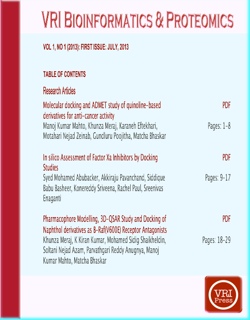
Molecular docking and ADMET study of quinoline-based derivatives for anti-cancer activity
Abstract
An In silico study was carried on a series of novel quinoline based inhibitors which were designed, synthesized and assessed for their in vitro activity versus the human colon cancer cell line HT29 and the human breast cancer cell line MDA-MB231 by Arafa RK et. al. We have designed these 22 inhibitors in ChemBioDraw ultra 12.0 and minimized using the LigPrep tool of Schrödinger 2011. A docking study of these inhibitors into different cancer proteins active sites was performed in order to give a suggestion to the proposed invitro mechanism of action. Some prominent cancer proteins specifically causing breast and colon cancers are used as targets in this computational study to predict the most active quinoline based derivative. The proteins are minimized using the protein preparation wizard and Grid is generated by specifying the active site amino acids. The binding model of best scoring inhibitor with each protein was assessed from their G-scores and disclosed by docking analysis using the XP visualizer tool. Interestingly the result of docking was found to match with the previous invitro study where the most active derivative against both tested cell lines was the Schiff’s base 4e. The pharmacokinetic parameters study was done using the QikProp 3.4 tool to display ADME and Toxicity properties of these inhibitors.
Keywords
References
Moscow JA, Cowan KH. Biology of cancer. In Goldman L, SchaferAI, eds. Cecil Medicine. 24th ed. Philadelphia, Pa: Saunders Elsevier;2011:chap 185
Giovanella BC, Stehlin JS, Wall ME, Wani MC, Nicholas AW, Liu LF, Silber R, Potmesil M: DNA topoisomerase I targeted chemotherapy of human colon cancer in xenografts. Science 1989, 246:1046-1048.
http://dx.doi.org/10.1126/science.2555920
PMid:2555920
Efferth T, Fu YJ, Zu YG, Schwarz G, Konkimalla VS, Wink M: Molecular target-guided tumor therapy with natural products derived from traditional Chinese medicine. Current Medicinal Chemistry 2007, 14:2024-2032.
http://dx.doi.org/10.2174/092986707781368441
PMid:17691944
Depowski PL, Rosenthal SI, Brien TP, Stylos S, Johnson RL, Ross JS: Topoisomerase IIalpha expression in breast cancer: correlation with outcome variables. Modern Pathology 2000, 13:542-547.
http://dx.doi.org/10.1038/modpathol.3880094
PMid:10824926
Lynch BJ, Guinee Jr DG, Holden JA: Human DNA topoisomerase II-alpha: a new marker of cell proliferation in invasive breast cancer. Human Pathology 1997, 28: 1180–1188.
http://dx.doi.org/10.1016/S0046-8177(97)90256-2
Al-Said MS, Ghorab MM, Al-Dosari MS, Hamed MM: Synthesis and in vitro anticancer evaluation of some novel hexahydroquinoline derivatives having a benzenesulfonamide moiety. European journal of medicinal chemistry 2011, 46:201-207.
http://dx.doi.org/10.1016/j.ejmech.2010.11.002
PMid:21112675
Mori M, Staniunas RJ, Barnard GF, Jessup JM, Steele GD Jr, Chen LB: The significance of carbonic anhydrase expression in human colorectal cancer. Gastroenterology 1993, 105:820-826.
PMid:8359652
Lock FE, McDonald PC, Lou Y, Serrano I, Chafe SC, Ostlund C, Aparicio S, Winum JY, Supuran CT, Dedhar S: Targeting carbonic anhydrase IX depletes breast cancer stem cells within the hypoxic niche. Oncogene 2012.
http://dx.doi.org/10.1038/onc.2012.550
Ghorab MM, Ragab FA, Heiba HI, Arafa RK, El-Hossary EM: In vitro anticancer screening and radiosensitizing evaluation of some new quinolines and pyrimido[4,5-b]quinolines bearing a sulfonamide moiety. European journal of medicinal chemistry 2010, 45:3677-3684.
http://dx.doi.org/10.1016/j.ejmech.2010.05.014
PMid:20684857
Millikan RC, Player J, de Cotret AR, Moorman P, Pittman G, Vannappagari V, Tse CK, Keku T: Manganese superoxide dismutase Ala-9Val polymorphism and risk of breast cancer in a population-based case-control study of African Americans and whites. Breast Cancer Res. 2004, 6:R264-274.
http://dx.doi.org/10.1186/bcr786
PMid:15217492 PMCid:PMC468618
Satomi A, Murakami S, Hashimoto T, Ishida K, Matsuki M, Sonoda M: Significance of superoxide dismutase (SOD) in human colorectal cancer tissue: correlation with malignant intensity. Journal of gastroenterology 1995, 30:177-182.
http://dx.doi.org/10.1007/BF02348662
PMid:7773347
Rashad AE, El-Sayed WA, Mohamed AM, Ali MM: Synthesis of new quinoline derivatives as inhibitors of human tumor cells growth. Archiv der pharmazie 2010, 343:440-448.
http://dx.doi.org/10.1002/ardp.201000002
PMid:20803621
Rizvi, Syed Umar Farooq, et al. "Discovery and molecular docking of quinolyl-thienyl chalcones as anti-angiogenic agents targeting VEGFR-2 tyrosine kinase." Bioorganic & medicinal chemistry letters 22.2 (2012): 942-944.
http://dx.doi.org/10.1016/j.bmcl.2011.12.017
PMid:22200597
Waldner MJ, Wirtz S, Jefremow A, Warntjen M, Neufert C, Atreya R, Becker C, Weigmann B, Vieth M, Rose-John S, Neurath MF: VEGF receptor signaling links inflammation and tumorigenesis in colitis-associated cancer. The journal of experimental medicine 2010, 207:2855-2868.
http://dx.doi.org/10.1084/jem.20100438
PMid:21098094 PMCid:PMC3005238
Seddon G, Lounnas V, McGuire R, van den Bergh T, Bywater RP, Oliveira L, Vriend G: Drug design for ever, from hype to hope. Journal of computer aided molecular design 2012, 26: 137–150.
http://dx.doi.org/10.1007/s10822-011-9519-9
PMid:22252446 PMCid:PMC3268973
Meraj K, Mahto MK, Christina NB, Desai N, Shahbazi S, Bhaskar M: Molecular modeling, docking and ADMET studies towards development of novel Disopyramide analogs for potential inhibition of human voltage gated sodium channel proteins. Bioinformation 2012, 8:1139-1146.
http://dx.doi.org/10.6026/97320630081139
PMid:23275710 PMCid:PMC3530882
Desai N, Mahto MK, Alekhya B, Naveen CR, Bhaskar M: Comparative docking studies of estrogen receptor inhibitors and their binding interaction analysis. Int. J. Pharm. Sci. Rev. Res. 2012, 16:91-95.
Abu Hammad AM, Taha MO: Pharmacophore modeling, quantitative structure-activity relationship analysis, and shape-complemented in silico screening allow access to novel influenza neuraminidase inhibitors. Journal of chemical information and modeling 2009, 49:978-996.
http://dx.doi.org/10.1021/ci8003682
PMid:19341295
Moroy G, Martiny VY, Vayer P, Villoutreix BO, Miteva MA: Toward in silico structure-based ADMET prediction in drug discovery. Drug Discovery Today 2012, 17:44-55.
http://dx.doi.org/10.1016/j.drudis.2011.10.023
PMid:22056716
Arafa RK, Hegazy GH, Piazza GA, Abadi AH: Synthesis and in vitro antiproliferative effect of novel quinoline-based potential anticancer agents. European Journal Medicinal Chemistry 2013, 63:826-832.
http://dx.doi.org/10.1016/j.ejmech.2013.03.008
PMid:23584545
Halgren TA, Murphy RB, Friesner RA, Beard HS, Frye LL, Pollard WT, Banks JL: Glide: a new approach for rapid, accurate docking and scoring. 2. Enrichment factors in database screening. Journal of Medicinal Chemistry 2004, 47:1750-1759.
http://dx.doi.org/10.1021/jm030644s
PMid:15027866
Friesner RA, Murphy RB, Repasky MP, Frye LL, Greenwood JR, Halgren TA, Sanschagrin PC, Mainz DT: Extra Precision Glide: docking and scoring incorporating a model of hydrophobic enclosure for protein-ligand complexes. Journal of Medicinal Chemistry 2006, 49:6177-6196.
http://dx.doi.org/10.1021/jm051256o
PMid:17034125
DOI: http://dx.doi.org/10.14259%2Fbp.v1i1.40
Refbacks
- There are currently no refbacks.








